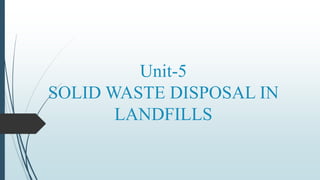This document provides information on solid waste disposal in landfills. It discusses site selection considerations for landfills including technical, environmental and social factors. It describes the design and operation of sanitary landfills including their multi-phase life cycle involving initial adjustment, transition, acid formation, methane fermentation and final maturation. Key processes at landfills include microbial degradation, settling of waste, and management of landfill gas and leachate. Selection criteria for landfills include technical, institutional, financial, social and environmental factors.
















































